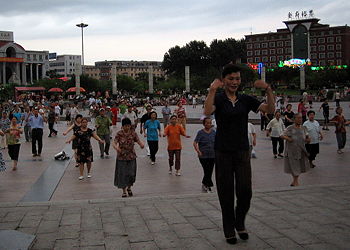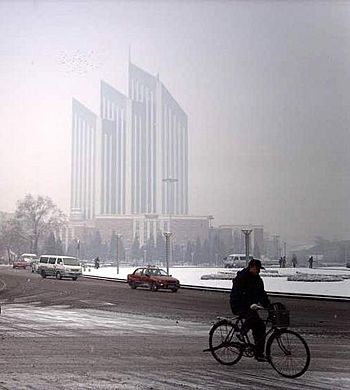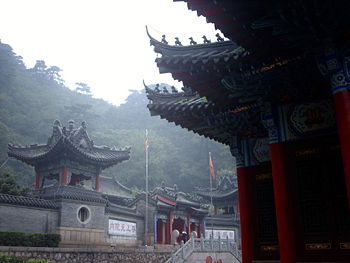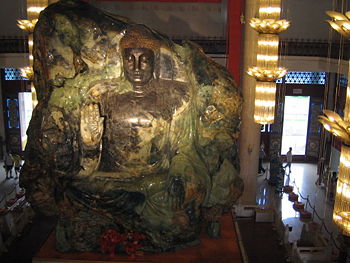Anshan
Ānshān (鞍山) is the third largest prefecture level city in Liaoning province of China. Situated in the central area of the province, it is about 92km south of Shenyang, the province's capital. Anshan is on the boundary between the Mountains of Eastern Liaoning and the plains of West. The area contains the famous Qianshan park. The city's name is derived form the shape of a nearby mountain (in Chinese shān 山) that resembles the shape of a horse's saddle (Ān 鞍). Anshan is home to the Angang Iron and Steel company, one of the largest steel producers in China.
History
The area of Anshan has been inhabited since prehistoric times. The area remained of little significance, overshadowed by neighboring Liaoyang city, until the late 1930's. During this time, Anshan was occupied by the Japanese and was part of the Japanese puppet state of Manchuco. The Japanese founded a iron and steel mill in Anshan. The city grew in size around this new industrial site. The defeat of the Japanese in 1945 saw Anshan returned to China. However, peace had not yet arrived. Civil war continued between the Chinese Nationalist Government and the Communist People's Liberation Army. The city of Anshan was the scene of one of the battles of this war. A monument in Lishishan park commemorates the battle. On the 19th of Feburary 1948, Anshan was liberated by the PLA.
The north east of china was marked out to become a major industrial center for the new People's Republic of China. Anshan was set to become a key part of this industrial development. In December 1948, the Anshan Iron and Steel Company - also known as Angang - was founded. Production in the newly repaired steel plant resumed on July 9th 1949. The plant was expanded to become, at one time, the largest steel producer in China. Other industries setup along side the steel plant including mining for coal, iron and other minerals. This industrial wealth had a environmental cost. The open-hearth furnaces of the steel mill created large amounts of dust and other pollution. Along with it's growing reputation as a major steel producer, Anshan was also gaining a reputation as a dirty, smelly town.
The furnaces of the steel plant were changed in the 1980's to designs which blow oxygen in form the front. This increased the production and also reduced the pollution. In the 1990's, they were additionally altered to blow oxygen in form the top as well. This further increase production and reduced pollution. In December 2000, all three production lines of Anshan Iron and Steel company switched form mould-casting to continuous casting. This new technology has significantly reduced the dust and other pollution in the city. The new plant equipment is also much less labour intensive. This has meant a reduction in the workforce has caused a unemployment problem in the city. A new drive to market Anshan as a tourist destination is hoped to help bolster the cities economy.
Population

Renmin Park may be small, but it is popular. Large crowds of people gather there every evening for meet and take part in activities such as Taichi, Ballroom and Line Dancing, Exercizing, playing music, flying kites and more. The woman is leading this group of men and woman in a line dance.
Tourist attractions
In recent years, Anshan has been trying to through off it's image as a heavy industrial town along with the dirt and pollution that goes with such industry. It has remodeled it's self as a tourist destination.
Foremost among the attractions in Anshan is Qianshan Park (千山) which is about 18km by road, to the south east of the city. Qianshan literally means, 'Thousand Mountains'. The name is actually and abbreviation of 'Thousand lotus flower mountains'. The peaks were said to resemble the petals of the lotus flower which had been dropped to earth by a goddess. The park area of 44 square kilometers, is filled with both Buddhist and Taoist temples, monasteries and nunneries. It is one of few locations where both religions are found sharing the same site.
Motor cars are not allowed within the park. Tourists must either walk or hire one of the electric taxi's. Many foot paths climb steeply up the hillsides through thick forest. These foot paths lead past, Steele, honoring the dead, small shrines, pagodas and temples. For those who are less fit, three cable car routes can convey you up the hill sides. However, none of the cable cars will take you the whole way, leaving you some climbing to do by yourself. One mountain in the park is shaped in such a way that it resembles a Matria Buddha. It is claimed to be the largest naturally occurring image of Matria Buddha in the world. Several temples have been built on the peaks of the overlooking hills. Near the Matria Buddha is a large net enclosed area which contains an bird park.
Another major tourist location is Anshan's 219 park. The name of the park commemorates the liberation of Anshan by the People's Liberation Army on the 19th of February 1948. The park contains the Dongshan (East Mountain) scenic area as well as numerous lakes. Of particular note is the Jade Buddha temple (Yufo yuan). This large Buddhist temple complex of 22,104 square metres, houses the worlds large statue of Buddha made of Jade. It is a single piece of jade stone measuring 6.88 metres in width, 4.10 metres front to back and 7.95 metres high. The jade stone weighs 260.76 tons. The front of the stone has been carved with an image of Sakyamuni (aka. Gautama) Buddha. On the back of the stone Guanyin (aka. Avalokitesvara) Buddha has been carved. The jade stone was found in 1960 in Xiuyuan County. It was declared a treasure of the State and listed as a protected property by Chinese Premier Zhou Enlai. Anshan city government commissioned the carving which took a team of 120 sculptures 18 months to complete. The temple complex was opened on the 3rd of September 1996. The building that houses the Jade Buddha statue is 33 metres tall, representing the 33 layers of heaven in Buddhism. It claims to be the tallest building of ancient Chinese architectural style in China.
Anshan contains naturally hot spring water spas. There are four spas/hotels in Anshan. Visitors may shower and bathe in the spring water. At Tanganxi Spa, once frequented by the Qin Emperors of China, visitors may have mud treatment where they are buried in hot volcanic sand, which has been infused with the spring water. The geothermal energy is also used to provide hot steam and water for winter heating throughout the area.
Transportation
Anshan has no public airport and no river or sea port so the only routes in or out are by land. The nearest airport is Shenyang Taoxian International Airport (SHE), about 90km to the north. The city is beside the Shanda highway (沈大高速公路) which runs between Shenyang and Dalian (the two larger cities of Liaoning province). This is a privately funded eight-lane tolled highway and was the first road of its kind in China. Anshan is also connected to the Chinese rail network with rail routes to Beijing, Dalian, and to the north-eastern provinces of Jilin and Hēilóngjiāng as well as to eastern Inner Mongolia and Russia. Long-distance coaches run to all the main cities of the province as well as to Beijing.
Local transportation is primarily by bus or taxi. Anshan used to have a single tram line along Zhonghua Avenue but this has been closed and the tracks removed. Due to the flat topography of the city centre, bicycles are popular. Almost all roads have a wide cycle lane on each side. Often this lane is further protected by a traffic island that separates the bikes from larger motor vehicles.
Industry
The north east of China is a major industrial zone and Anshan is one of the key sites of the north east. The city is renowned as "China's capital of iron and steel." The Anshan Iron and Steel Company (Angang) was founded in 1948. Form then to 2001, the company produced 290 million tons of steel, 284 million tons of pig iron and 192 million tons of rolled steel. Until relatively recently, when a new steel plant opened in Shanghai, Angang was the largest steel producer in China. Today, Angang consists of three steelworks with 13 rolling mills plus supporting plants which produce coke, refractory materials and machinery for the steel plants. The company has an annual production capacity of 10 million tons of pig iron, 10 million tons of steel and 9.5 million tons of rolled steel. A quarter of China's total iron ore reserves, about 10 billion tons, are located in Anshan ensuring that the city will remain an important steel producer well into the future.
Anshan is rich in other mineral wealth too. The southern and southeastern areas of Anshan are rich in magnesite. Reserves of magnesite here are equivalent to a quarter of all world wide reserves. Anshan also has the worlds largest reserve of talcum. The Xiuyan area of Anshan is known for it's the production of the precious stone, Jade.


